The Carretera Austral, a triumph of Chilean engineering and a relic of the ruthless Pinochet dictatorship. Once isolated northern Patagonian towns eventually connected by a passable terrestrial thoroughfare after 20 years of blood, sweat, tears and frostbite. A growing by-product of this mammoth effort is now tourism. Independent travellers looking to take on a gravelled, dusty and twisty trail, and it seems, by any means possible.
The 1,240km stretch of this major Chilean highway (officially marked as the Ruta 7) starts from the north in the gritty, industrial transport hub of Puerto Montt and extends south to the isolated dead end at Villa O’Higgins. While neither town is particularly packed with attractions, the Carretera Austral is definitely a time when the overused journey versus destination cliché comes into its own.
Magnificent mountain vistas, sleepy towns, gorgeously green national parks, hilltop hikes, crevasse-riddled glaciers and packs of friendly free-range dogs all await visitors who step out into the unknown are willing to take on the road less paved. Most drive, many cycle, hitchhiking replaces buses and a few have been known to even walk.
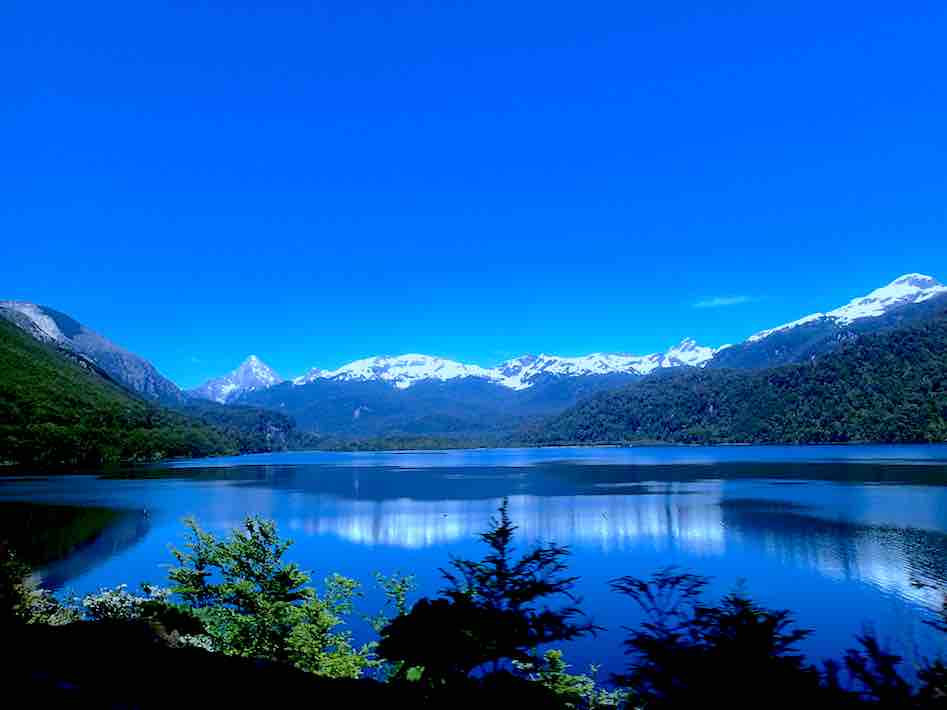
Spoilt by scenery. Lago Yelcho, just south of Chaiten on the Carretera Austral
A Driving Guide to the Carretera Austral
No matter the method, the Carretera Austral is not without its logistical and mental challenges. After spending a few weeks on rutted roads of the Ruta 7 in our trusty Toyota I felt compelled to compile some tips and tricks for the prospective road tripper. While some of this information may be still useful for cyclists, hitchhikers and other adventurers, the focus will be on specifics associated with driving a vehicle.
Getting to the Carretera Austral
For a major Chilean highway, it actually takes a bit of getting to. There are however a number of options based on your preferred entry and departure points.
From Puerto Montt
Heading south from Puerto Montt is the most logical and popular starting point. However, before you reach the first major town of Chaiten you will have experienced 3 ferry crossings, one of which is at least 4 hours long! Some road trip you say! You’ll soon realise this is commonplace when connecting islands and inlets when a road isn’t feasible in this part of the country. If your more of a land lover than a sea farer you may instead wish to experience the mystical charms of Chiloe. If this sounds like you, keep reading…
From Chiloe
Isla Chiloe is south-west of Puerto Montt and runs parallel to Ruta 7 for over 200km. A very scenic island that you can easily spend a few days on. You can also follow the 30,000km Pan-American highway to its terminus at Quellon. Quellon is located at the southern tip of the island and Naviera Austral run a twice-weekly ferry service to Chaiten on the Carretera Austral. True, you need to get a short ferry on to Isla Chiloe and then a 4-5 hour ferry to the Ruta 7, however it allows you to experience both the unique Chiloe and the Carretera Austral and avoid backtracking at all. This was our preferred route, bringing us into Chaiten at midnight.
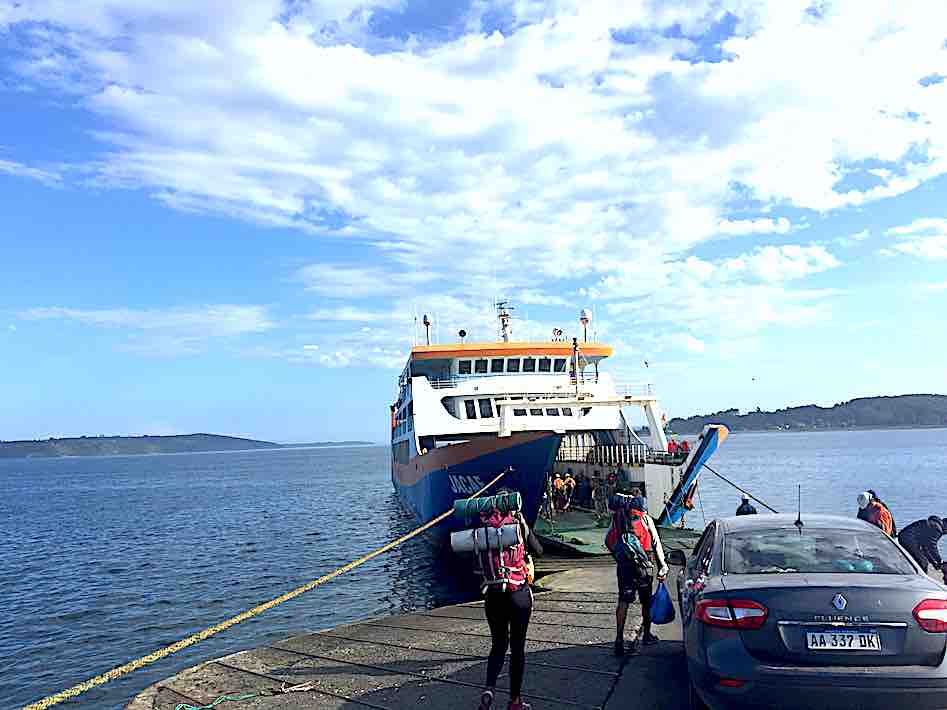
Boarding the Naviera Austral Ferry at Quellon on Isla Chiloe.
From Argentina
There are a number of border crossings in from Argentina that arrives mid-way along the route. So, if you are heading north from Argentina, these are all viable options to cross into Chile and experience some or all of the Ruta 7. Balmaceda provides the easiest route (on sealed roads) arriving at Coyhaquie; Chile Chico is an adventurous but extremely scenic route joining the Ruta 7 at Villa Rio Tranquillo with access to the marble caves and San Rafael glacier (see below); Paso Robollos is a more remote and possibly a 4WD only option entering the Ruta 7 further south near Cochrane. For us, Chile Chico was an exit point and can highly recommend the route, rough in parts but very scenic and doable in a high clearance 2WD.
Read our guide for crossing Chilean borders in a Chilean car
From Villa O’Higgins
There is no way to begin your car journey from Villa O’Higgin’s. Apart from the Carretera Austral itself, there is no other way to access Villa O’Higgins in a vehicle and (at time of writing) there were no car hire options available. For pedestrians, and cyclists you can access Argentina via a trail arriving north of El Chaiten at Lago Desierto.
See at the bottom for information on how to get off the Carretera Austral.
Carretera Austral Road Surface
Renown as a rough journey, the paved sections of road are more common in the northern parts and are surprisingly some of the best surfaces in Chile! But that is not what you came for, bring on the gravel you say! Well with constant roadworks, avalanches and mysteriously unfinished sections it won’t be long before you see your first ‘fin pavimento’ sign, quickly followed by a rough interruption of gravel roads, known locally as ‘ripio’. This will reduce your maximum (and advisable) speed to about 40kph.
Once you pass the town of Cerro Castillo the surface almost all turns to ‘Ripio’ for the rest of the southern section, requiring constant focus for umpteen potholes waiting to rip your wheels off, stones wanting to puncture your gas tank and corrugations keen to send you sideways around tight bends. For the driver, the distracting scenery is the hardest challenge, so pull over and take your pictures and take time to soak it all in undistracted.
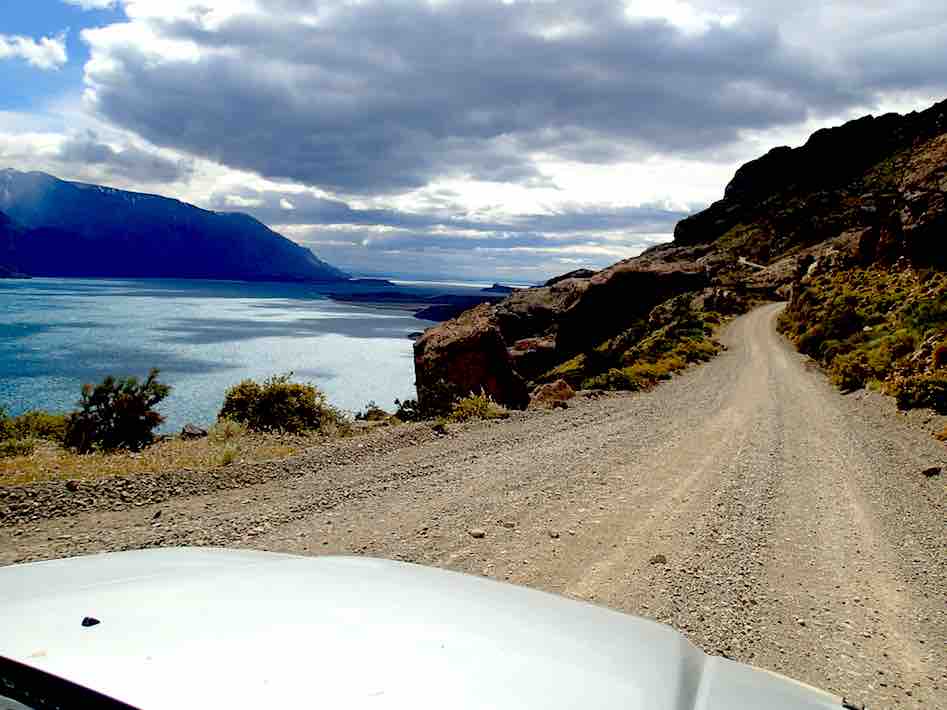
Ripio, the local word to describe the main surface of the Carretera Austral. Easy to get distracted by the views also!
Choice of Vehicle
While we’d all like a pimped out, high spec, custom built, off-road machine to take to a road like the Carretera Austral, it is likely you will be limited to rental car options or your locally purchased wheels on a budget. It’s fair to say most standard vehicles have and will make it along the entire route. It will be the degree of comfort, speed and risk of damage and breakdowns that will vary a lot based on the vehicle you choose.
Above all else, high clearance would be the most important factor followed by good suspension and quality tyres. Some sections are quite rough and rutted and having the ground clearance will help reduce damage to the underside of the vehicle. A 4×4 is not needed but may provide better grip and by nature have a higher clearance. There not many real muddy or super sandy sections to get bogged in on the main route, it just may limit some side-trip options.
Mostly, you’ll get rattled around for hours on end and while the scenery will take your mind of this most of the time, it can get a bit tiresome. So, good suspension and larger wheels should help with that a lot and don’t put the wheel pressures up to their maximum. About 75% would be recommended. For reference, we had a Toyota 4Runner (2WD) and this was very well suited. See our full guide to buying and selling a car in Chile.
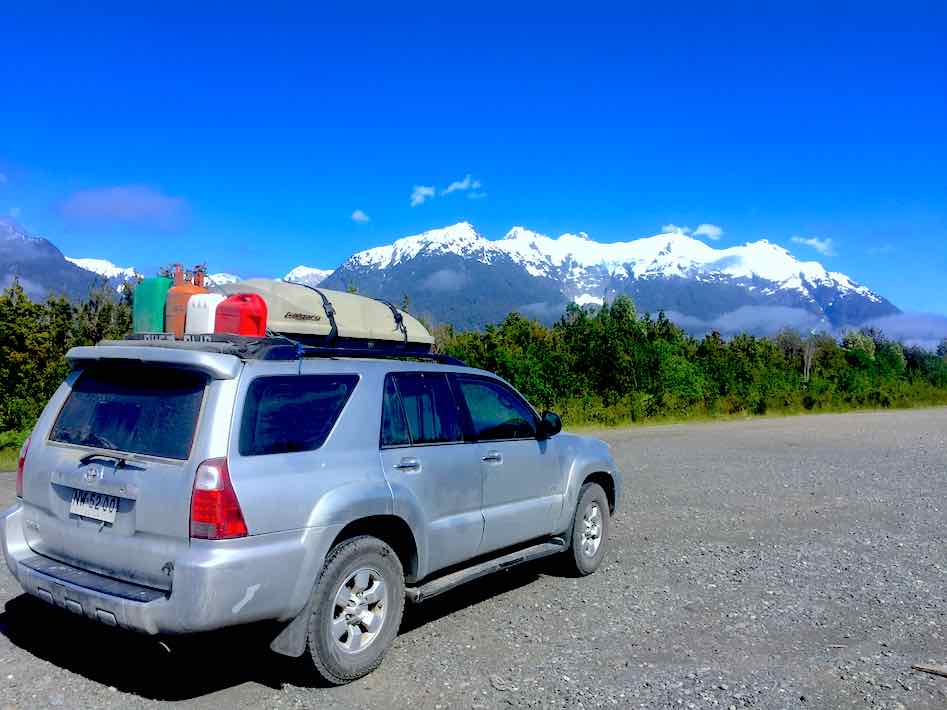
With high clearance, good tyres and suspension, our 2WD Toyota 4Runner did the Carretera Austral with ease.
Fuel
Despite the remoteness, north of Villa Rio Tranquillo at least, fuel stops, both diesel and gasoline, were frequent enough to not require the need to carry extra fuel. It is good practice to fill up every time you see a gas station, even if you are on 3/4 full. Most towns along the route sell fuel even if towns are few and far between. If you are headed south past Cochrane to Villa O’Higgins it is advisable to take extra fuel just in case.
There are some reports of diesel being diluted at some stations on the Ruta 7. Our Toyota ran on gasoline so we didn’t experience this first hand or in fact speak to anyone about this happening to them directly.
Traffic
As a remote regional road, you can travel for an hour on the Carretera Austral and only pass one or two other vehicles. With the Carretera Austral being a crucial transport link through southern Chile the most common vehicle encountered will though be trucks. These trucks travel fast and won’t slow down when they pass. It is best to pull for trucks completely, as far as you safely can and wait for them to pass. Firstly, to avoid a serious collision and second, to avoid a broken windscreen from flying rocks. Remember to wind your windows up when any vehicle passes to avoid a face full of dust and keep the air-con on recycled air.
Keep your lights on during the day for safety as it can be hard to see vehicles through the freshly kicked up dust. Keep an eye out for cyclists, and give them a wide berth and slow down so as not to kick up too much dust in their face either, they’re doing it tough enough already!
Lastly, driving after dark is not a good idea, limited signage and absent barriers in a lot of sections could have you drive off the road unawares. Plus, wildlife is a lot more active at night putting both them at risk and yourself as you try and dodge them.
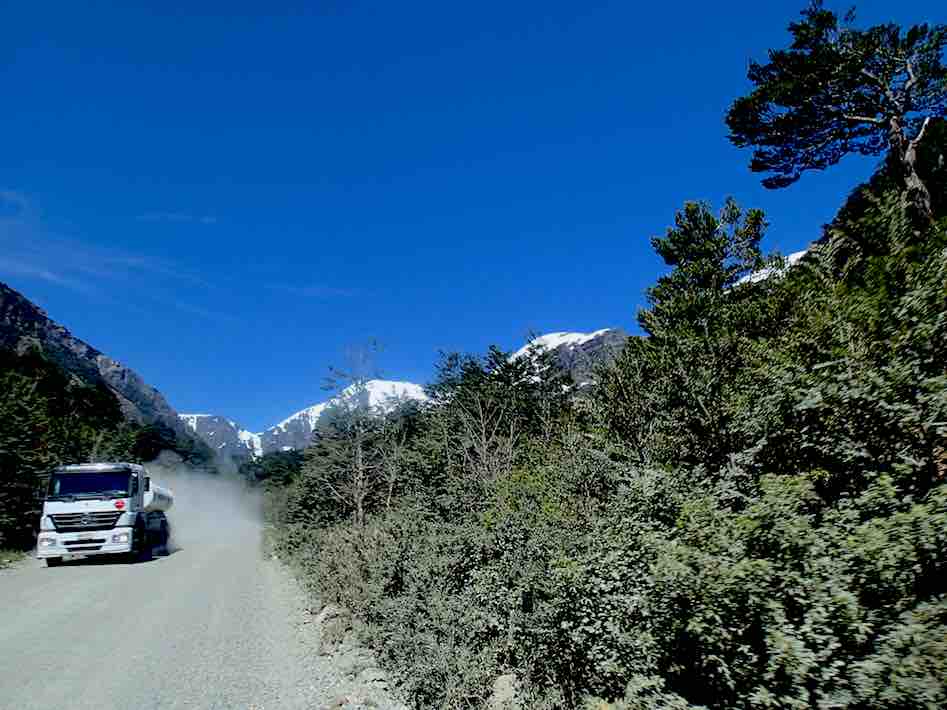
Bearing down on you at great speeds, trucks are best yielded to!
Roadwork
At very regular intervals there is roadwork where only one lane is open while they work on the other. This leaves long waits as the oncoming cars file through. These sections are all manned by remote road workers holding red Stop (Pare) and green Ready (Listo) signs. As frustrating as it might seem to have to stop in the middle of nowhere, it’s a good opportunity to stretch the legs a little. Trying to rush the Carretera Austral is another bad idea. Add double the time to whatever Google Maps tells you for road works and of course for stopping to take photos!
We were stopped for an hour due to a recent avalanche which had taken out the road completely. Luckily, I suppose, this was on the side of a lake which allowed a small ferry to be employed to carry traffic around the affected area.
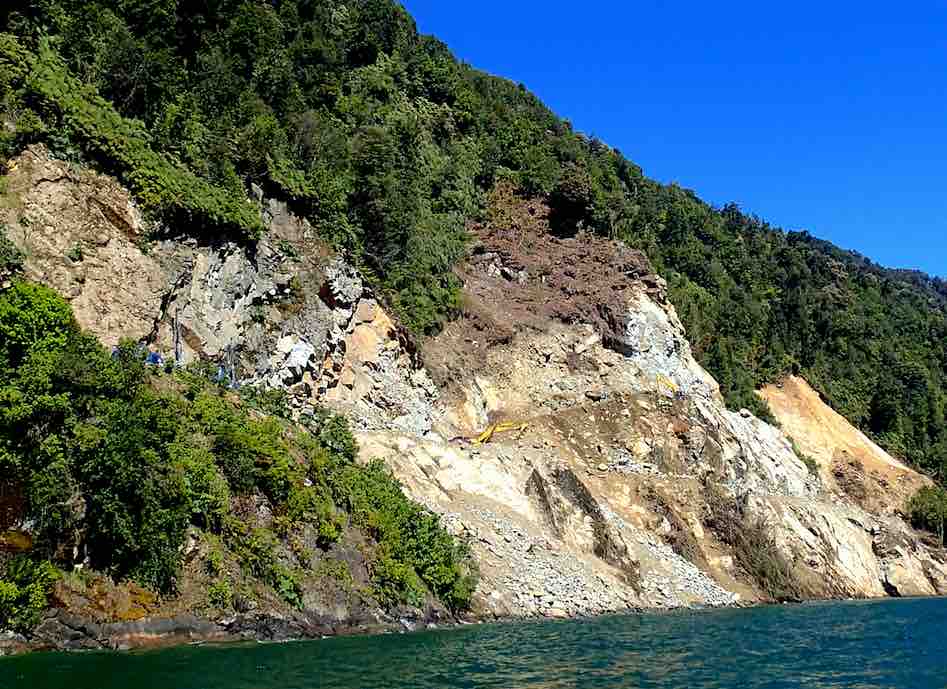
The section of the road completely unpassable due to avalanche. Instead, a makeshift ferry took us around the damage.
Breakdowns/Repairs
Not a pleasant thought but with a rough road lots of poorly maintained vehicles it is a potential outcome. Thankfully we had no issues apart from a flat tyre before leaving Puerto Montt. In fact, flat tyres are the most common issue so make sure your tyres, including the spare, are in ship shape (plus carry an automatic pump for slow punctures to allow you get you to a town). Apart from Puerto Montt and Coyhaique, there will be limited mechanical workshops to get spare parts and assistance.
If you do run into trouble, move your car as far off the road as possible, limp to a wide shoulder of the road if you can. Seek help from other drivers and, depending on the seriousness of the issue, you may need to hitch a lift to organise assistance. One of the nice parts of the Carretera Austral is that fellow road users look out for each other given the remoteness of the location so you can expect someone to stop and help, likely more so than in your hometown! So, stop if you see anyone in trouble also J
Carry some basic tools and ensure you carry water, food and even consider a sleeping bag just in case you need to stick it out overnight for assistance.
Mobile Coverage/WiFi
With the exception of Coyhaique, there is pretty limited mobile coverage the entire route. Depending on your provider, larger towns may have some coverage and you may get wifi access in one of the few hotels and restaurants if you are lucky, but plan for none. Get a map, download google maps and get an old-fashioned guidebook for highlights and make any must have reservations before you set out.
Sights & Activities
With dramatic mountain scenery along the entire route, there is plenty to see along the way. In fact, it will be difficult to keep your eyes focused on the road, so stop often and take in the sights. Some key points of interest from our experience are below, along with some logistics, but this is far from an exhaustive list.
Ventesquero Colgante (Hanging Glacier)
About 200km south of Chaiten is Parque Nacional Queulat which has a number of attractions, the highlight being Ventesquero Colgante, known as the hanging glacier. An easily accessible attraction a few kilometres off the highway. The glacier sits on top of a 900m cliff face with a persistent waterfall spouting from underneath into the green glacial lake below. The whole setting is quite spectacular.
After entering the National Park (5,000 CLP per person) the glacier is visible after a short 15 min walk. A boat also runs (albeit inconsistently) close to the base of the waterfall. There is pleasant longer 2-3-hour moderately uphill hike to get a closer view of the glacier but the lookout is still quite a way. It’s a nice walk through the forest (or would even make a nice morning trail run) direct from the Conaf campground!
Cerro Castillo
Another Glacier fed lake sits beneath the spires of Cerro Castillo, located about 300km south of Parque Nacional Queulat. While the granite spires are visible from the road, the lake isn’t. A 7-8-hour return hike is required to get this extremely rewarding view to see an iceberg riddled lake with massive spires dominating the background. The one-day hike is part of a more publicised 4-day circuit around the spires.
The town of Cerro Castillo is quite small with limited services. The turn-off to the trail head is immediately before hitting the town at a sharp, blink-and-you’ll-miss-it tight right turn. Free camping is possible at the entrance to the hike. An entry fee of 10,000 CLP per person is required to do the hike. It was expensive compared to other entrance fees but I would say the price matches the experience, it is easily one of the best and most varied hikes done on our entire 3-month trip. Plus you save on camping fees for the night!
Read a full report on hiking Cerro Castillo in one day.
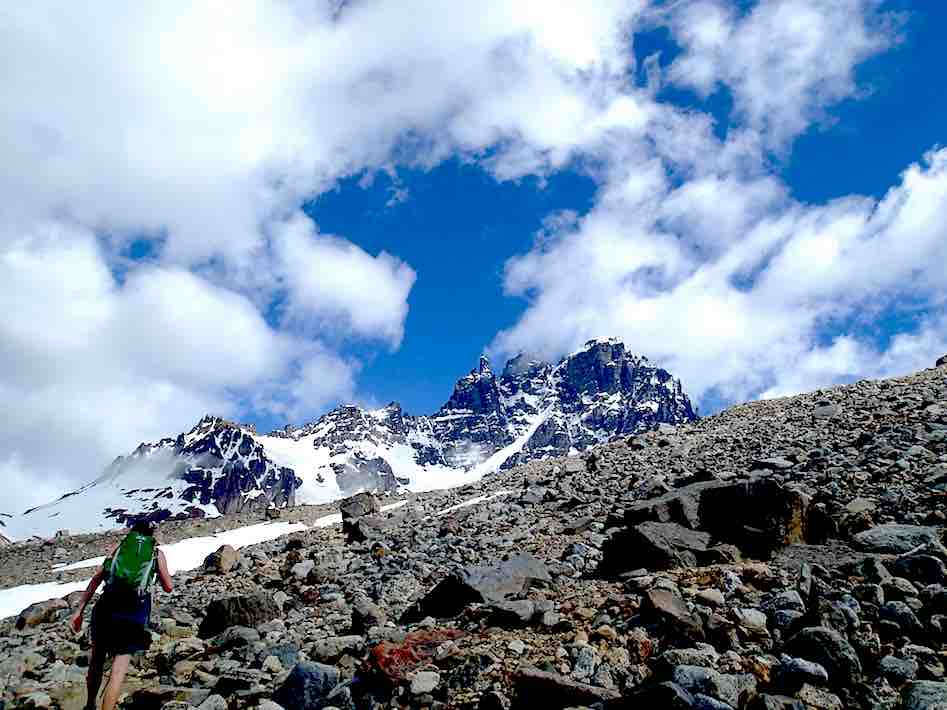
Hiking Cerro Castillo.
San Rafael Glacier
One of the first of the big glaciers heading south through Patagonia. San Rafael Glacier descends down from the northern Patagonian icefield and empties into a Laguna of the same name. Icebergs are everywhere and large chunks of ice calve off the glacier constantly. Getting close to the face of the glacier requires some effort (and at some expense) but it is cheaper and easier to access for an independent traveller now than when it once was.
To access San Rafael glacier from the Carretera Austral you ultimately need to take a boat tour. The boats leave from Bahia Explorodores which is accessible via a newish road from the Villa Rio Castillo, the X-728. However, that is only part I of the story.
Boat tours need to be booked in advance and the cost is 145,000 CLP. Not a trivial sum but I can say overall the trip was as close to an Antarctic-like experience as I’ve ever had, so in that respect, it is very cheap! Tickets can be booked from Villa Rio Castillo. We booked ours the day before but it might be cheaper for more advanced bookings. While we were sceptical about the makeshift tour office (in a man’s back shed) and the ticket being suspect (the microscopic credit card machine receipt) it turned out to be all legit! This, however, is only part II of this story.
There is no transport provided as part of the tour to Bahia Explorodores from Rio Tranquillo. So, you’ll need to drive the 90km (2 hours) along the new X-728 yourself. This is a very enjoyable scenic drive into what feels like a Jurassic park land of the giants’ type setting. There is a very visible Glacier Explorodores and numerous waterfalls and lakes to observe. The road, despite being new, it a lot more potholed and narrow than the Carretera Austral and less trafficked. As a result, most drive in the middle of the road for the smoothest drive and pull to the side when other vehicles approach. This is only part III of the story…
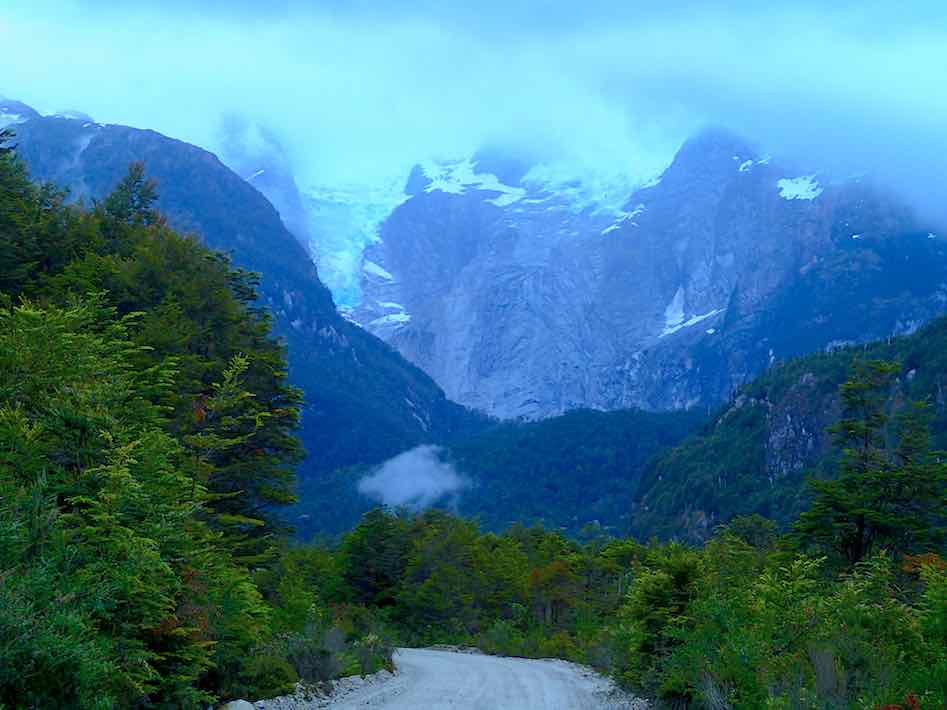
Heading towards Glacier Explorodores
The boat tour to the glacier leaves at 9 am. You can either leave early from Villo Rio Tranquillo and arrive in time for the boat (allow 2.5 hours for a stress-free drive) or arrive the night before and camp at the jetty. While there is some campsites and cabins en route, there is no official accommodation or camping sites at the boat jetty. There is some grassed space nearby to pitch a tent or you can just stay in your car or ideally campervan for the night. But, this is only part IV, now to the most crucial part of the story…
The most important point in all of this is there is no clear signage to the actual boat jetty. The road looks like it ends at ‘Rio Explorodores’. However what looks like a footbridge is actually a very narrow car bridge which only takes one car at a time and would fit nothing wider than a conventional passenger vehicle (our Toyota 4Runner only just fit through). After this bridge, it is another 10 kilometres (on a worse road) to the boat jetty and the true end of the road at ‘Puerto Explorodores’ where the boats can be seen moored to the jetty. If in doubt ask what few people you can find to clarify the situation. Take a brochure from the tour office for reference.
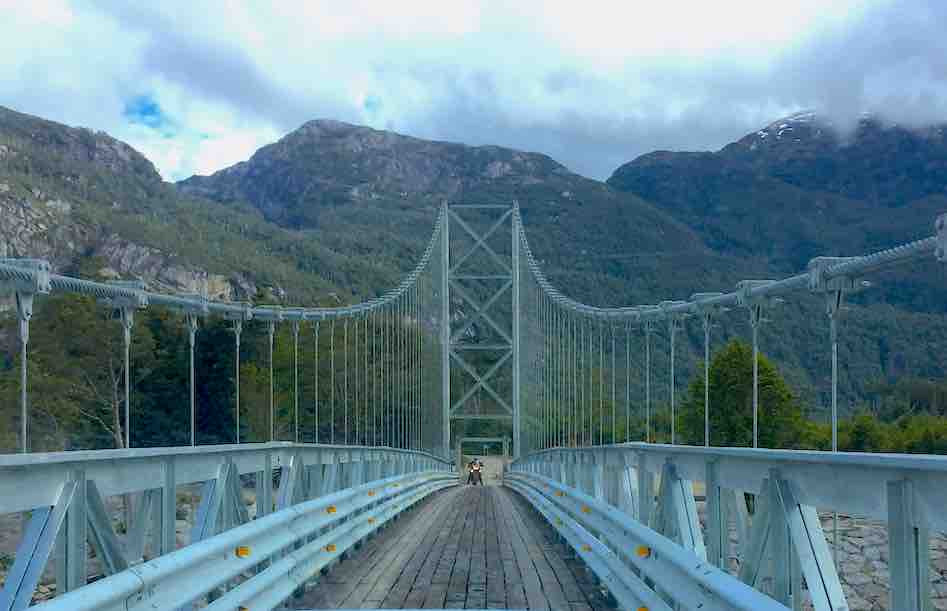
The single lane bridge crossing over Rio Explorodores en route to San Rafael Glacier boat jetty.
Despite the costs and worrying logistics, the San Rafael glacier is worth the effort. The small boat only holds 10-15 people so is an intimate and rewarding trip. It includes a decent packed lunch and a shot of whiskey out of freshly calved ‘millennia-old’ glacial ice. This part may sound cheesy but in reality, it’s pretty cool to sit back sipping a whiskey with just a handful of your newest friends in the middle of nowhere looking at something so spectacular carved by nature.
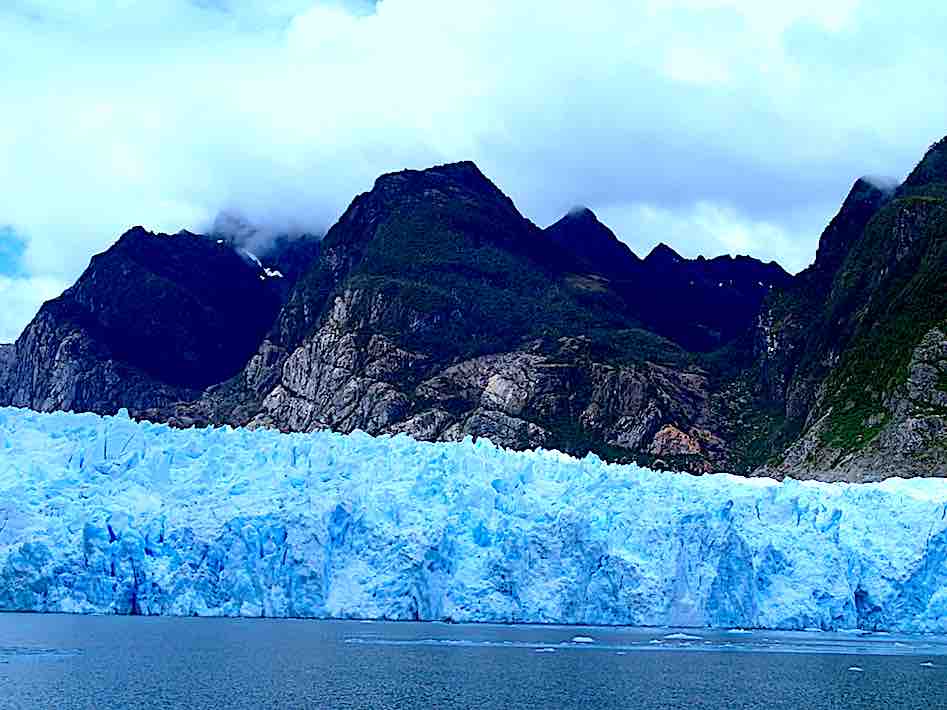
San Rafael Glacier
Getting off the Carretera Austral
While the Carretera Austral is 1,240km long one-way, if you want to do the entire route using a vehicle, and continue your travels only in Chile, this is essentially an out and back trip from Puerto Montt! Villa O’Higgins is, as mentioned, a dead end for vehicles at least. To avoid travelling the entire Ruta 7, twice, there are a few options to consider but need prior planning.
Continue north or south in Chile (via Argentina)
From the end of the road at Villa O’Higgins, you will need to backtrack 250km to one of the before mentioned Argentinian border crossings (in order from north to south; Balmaceda; Chile Chico; Paso Robollos). There is simply no road connections south to Chilean Patagonia without going via Argentina. Similarly, there are no other road connections heading north (other than the Ruta 7).
Leaving Chile in a Chilean registered vehicle provides some complexity so make sure you look into what is involved to exit Chile. Oh, and any fruit, vegetables, meat, milk and even spare fuel will most likely be taken on the Argentinian side, so make sure you use all that up beforehand!
Read our guide for crossing Chilean borders in a Chilean car
Continue north in Chile
If you can’t or simply don’t wish to cross to Argentina. You will backtrack at least two-thirds of the Ruta 7. Similar to the access option, from Chaiten you can cross to Isla Chiloe on the Naviera Austral ferry with your vehicle, this will avoid the 3 ferry crossings required to get to Puerto Montt. Chiloe is worth the trip, it’s lovely scenery and history along with a unique culture to the rest of Chile. From the top end of Chiloe, it’s really easy to get back to the ‘mainland’ using the short ferry crossing to Puerto Montt following the Ruta 5.
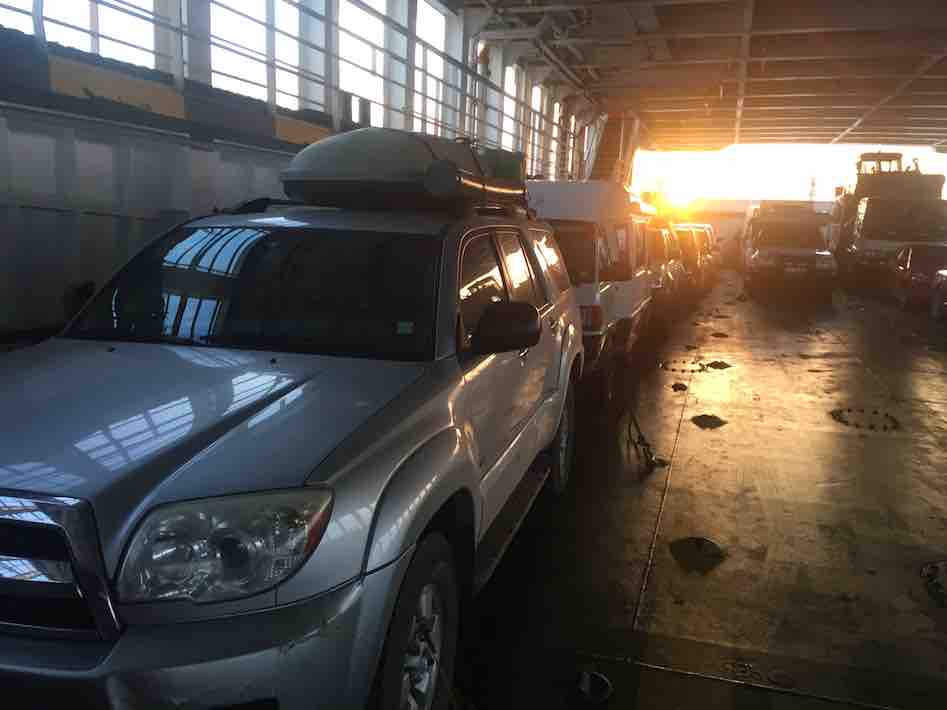
Our trusty Toyota in the hold on the Naviera Austral between Chiloe and Chaiten.
Enjoy the Drive!
Like all great road trips, there are so many small attractions you will encounter and you can make it a choose-your-own-adventure approach will make it unique to you. But we hope this information from our experience on the Carretera Austral leaves you better informed on the key aspects. Mostly, we remember all the great scenery and stopping to take photos constantly. The hikes and side trips (of which there are many) are not essential to enjoying the trip. Simply exploring the road less paved is and was for us a unique and enthralling experience in itself.
We’re happy to provide any further information you need to plan for your Carretera Austral or Chilean trip so please just get in touch, shoot an email to us at [email protected]
Cheers!
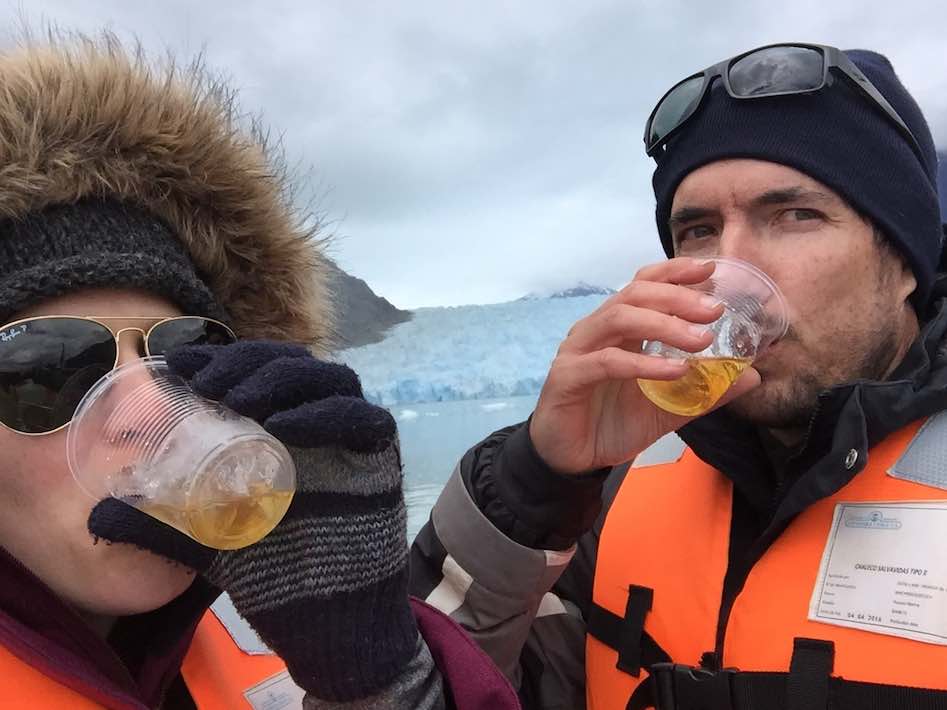
Have a great trip from us on the Carretera Austral! This is us enjoying a whiskey at San Rafael glacier.
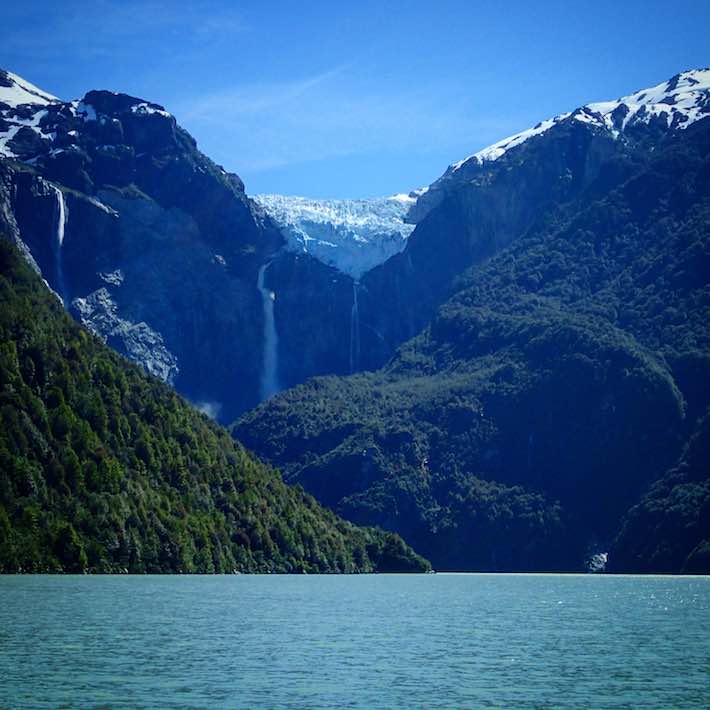












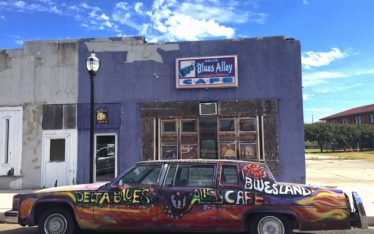

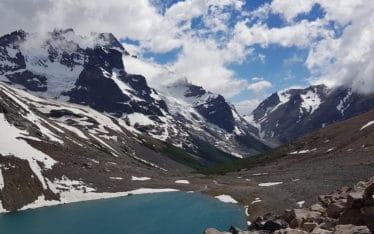
About The Author
Warren
Ever since venturing out the back gate into the bush as a kid, I've had a curiosity to escape and explore as often as I could. It's fair to say that my curiosity has continued to grow instead of fade as the years go on. It eventually came time to turn a few scribbled notes into some legible stories and travel tips for anyone with a similar curiosity as me.